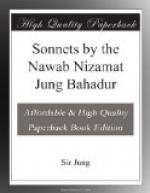To analyse the variations of the Shakesperian, Spenserian and Miltonian forms is, however, unnecessary to our present purpose, as the Sonnet Sequence we are now prefacing is based on the Petrarchan model. Strictly speaking, the Petrarchan sestet (the last six lines) should have three separate rhymed sounds; the first and fourth lines, the second and fifth, and the third and sixth should form the three rhymes. But this rule is by no means invariably followed; even Wordsworth and Rossetti often rhymed the first with the third, and the second with the fourth lines; and sometimes used only two sounds,—the first, third, and fifth lines making one rhyme and the second, fourth, and sixth the other.
As already said, these liberties are permitted, for the sestet is not under such arbitrary regulations as the octave.
There are writers who keep all the rules, and yet leave their readers cold; and others who are technically less correct, but in whom the vigour and intensity of emotion is swiftly felt and silences adverse criticism. The ideal is to combine deep and exalted feeling with perfect expression, and produce a whole which goes to the heart like a beautiful piece of music, and satisfies the mind—like one of those ancient Greek gems which, in a small space, presents engraved images symbolic of sublime ideas vast as the universe.
The Nawab Nizamat Jung has written in English several sonnets which we should admire even if English were his native language. But if any of us would like to form some estimate of the difficulties he has surmounted, let us sit down and try to express in a sonnet in any foreign language our own thoughts and beliefs. We shall then the better appreciate what he has achieved.
As, however, while the Great War lasts, few of us have leisure for literary experiments, it will perhaps be best to read these Sonnets primarily for their soul and spirit. In melody and expression they are of varying degrees of merit and completeness, but in the inspiring ideal they consistently embody they rise to heights which have been scaled only by the noblest. In tone and temper—as already said—they are akin to the Sonnets to Vittoria Colonna by Michelangelo,—of whom it was written by one who knew him well, “Though I have held such long intercourse with him I have never heard from his mouth a word, that was not most honourable.... In him there are no base thoughts.... He loves not only human beauty, but everything that is beautiful and exquisite in its own kind,—marvelling at it with a wonderful admiration.”
Here we see defined the temperament of the heroic poet, that inner nobility and exaltation without which mere technical skill can avail little in moving and holding the hearts of men.
This note on the structure of the Sonnet would fail in its purpose if it distracted the reader from the spirit behind the form;—for the spirit is the life,—and few who read these Sonnets will deny that the spirit of Nizamat Jung is that of the true poet, ever striving to look beyond ephemeral sorrows up to the Eternal Beauty—now hidden behind a veil, but some day to be revealed in all its splendour and completeness.




